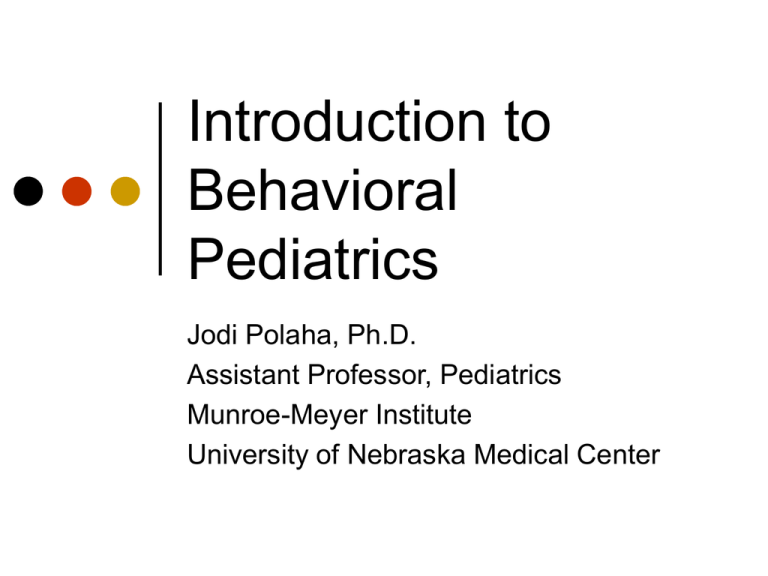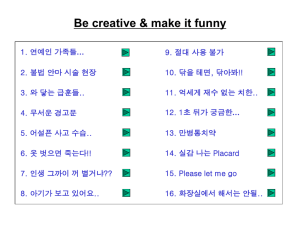Introduction to Behavioral Pediatrics
advertisement

Introduction to Behavioral Pediatrics Jodi Polaha, Ph.D. Assistant Professor, Pediatrics Munroe-Meyer Institute University of Nebraska Medical Center Overview Encopresis Enuresis An empirically-supported approach to day time toilet training An empirically-supported approach to night time toilet training Encopresis Repeated passage of feces into inappropriate places whether involuntary or intentional At least one such event a month for 3 months At least 4 years old Not due to direct effects of substance or medical condition except constipation With constipation and overflow incontinence Without constipation and overflow incontinence Encopresis Medical Workup/Management Bowel habits assessment Education Diet assessment/Changes Compliance/Behavioral protocol Encopresis Medical Workup/Management Assessment of etiology • Slow moving bowels vs. Spina Bifida or Hirschsprung’s disease If constipation – “clean out” Laxatives, stool softeners, or fiber for maintenance Encopresis Medical Workup/Management Bowel habits assessment Encopresis Medical Workup/Management Education Symptoms of constipation Functioning of bowel Behavioral “causes” Diet Encopresis Medical Workup/Management Education Diet assessment/Changes Diet diary Behavioral protocol to increase fiber • Premack principle Encopresis Medical Workup/Management Education Diet assessment/Changes Behavioral Protocol (to be discussed) Enuresis Repeated voiding of urine into bed or clothes (whether involuntary or intentional) Behavior is clinically significant (at least 2x/wk for 3 mos or causes impairment) At least 5 years old (developmentally) Not due to substance/medical condition Enuresis Primary vs. secondary Nocturnal vs. diurnal Enuresis Medical evaluation Assessment of compliance Behavioral protocol First time toilet training Among top concerns expressed by mothers on internet, call-in services Most frustrating Lots of “lore” First-time toilet training Passive “child-oriented” Brazelton, 1962 Physical maturity, interest, and “psychological readiness” “relax, be patient” Intensive “toilet-training in a day” Azrin & Foxx, 1974 Physiological readiness and compliance Principles of operant conditioning Empirically supported toilet training Thinking time question #1a: How could you provide a child with lots of practice in toileting? Empirically supported toilet training Thinking time question #1a, b: How could you provide a child with lots of practice in toileting? How could you provide predictabilty in structuring programming? Empirically supported toilet training Thinking time question #1a, b, c: How could you provide a child with lots of practice in toileting? How could you provide predictabilty in structuring programming? How could you provide a high contrast to help skill acquisition? Empirically supported toilet training Toilet Training in a Day (Azrin & Foxx) Repetition • Fluid load • Frequent toilet sits • Pants checks Empirically supported toilet training Toilet Training in a Day (Azrin & Foxx) Repetition • Fluid load • Frequent toilet sits • Pants checks High Contrast • Rewards for compliance with sits, successful voiding in toilet, and dry pants • Clean-up and overcorrection for wetting Empirically supported toilet training Toilet Training in a Day (Azrin & Foxx) Repetition • Fluid load • Frequent toilet sits • Pants checks High Contrast • Rewards for compliance with sits, successful voiding in toilet, and dry pants • Clean-up and overcorrection for wetting Predictability • Consistent schedule for toilet sits/pants checks • Star chart with grab bag • Use of attention Empirically supported toilet training Institutionalized incontinent adults Typically developing children with toileting resistance Mass audience of first-time learners Empirically supported toilet training Thinking time question #2: What if the child refuses to sit on the toilet? Encopresis Thinking time question #3: What would be a good behavioral protocol for a child who is soiling daily after school? Enuresis Thinking time question #4: What would be a good behavioral protocol for a child who is wetting daily at daycare? Empirically supported treatment for nocturnal enuresis Assessment Education Urine alarm Support to maintain integrity Empirically supported treatment for nocturnal enuresis Assessment Education Prevalence Medication vs. Urine alarm Empirically supported treatment for nocturnal enuresis Assessment Education Urine alarm Overlearning Dry-bed training Arousal Training • Reward for waking to moisture alarm Empirically supported treatment for nocturnal enuresis Assessment Education Urine alarm Support to maintain integrity Nocturnal enuresis Thinking time question #5: What if the child won’t wake to the alarm? Nocturnal enuresis: Trouble shooting “Darren” 13 year-old Caucasian male No medical, psychiatric, academic history or concerns Life-long history of bedwetting Two, one-year trials with moisture alarm. Currently treated with DDAVP Darren Number of Wet Beds Per Week 16 14 12 Wet Beds Pre Treatment Wet Beds 1 DDAVP 10 8 6 Wet Beds 2 DDAVP 4 2 June June June June May May May May April April April April 0 Darren Number of Times Mom Intervened At Night 16 14 12 10 Mom Pre Treatment Mom with 1 DDAVP Mom with 2 DDAVP 8 6 4 2 June June June June May May May May April April April April 0 Darren: Treatment Plan Sleep assessment: Rule out apnea Operant training: Wake to alarm Maintenance: Medication, no alarm Darren: Treatment Plan Arousal Training Familiar, loud, clock-radio. Contingency for success. Two alarms per night. Darren: Treatment Plan Alarms Week 1: 5:00 a.m. and 7:00 a.m. Week 2: 5:15 a.m. and 6:45 a.m. Week 3: 5:30 a.m. and 6:30 a.m. Week 4: 6:00 a.m. Week 5: 6:00 a.m. Week 6: 6:30 a.m. Darren Number of Wet Beds Per Week Ap ril Ap ril M ay M ay Ju ne Ju ne Ju ly Ju l Au y gu st 16 14 12 10 8 6 4 2 0 Pre Treatment 1 DDAVP 2 DDAVP 2 DDAVP + Alarm Darren Number of Times Mom Intervened At Night Ap ril Ap ril M ay M ay Ju ne Ju ne Ju ly Ju l Au y gu st 16 14 12 10 8 6 4 2 0 Pre Treatment 1 DDAVP 2 DDAVP 2 DDAVP + Alarm Darren Frequency of Self-Waking to Toilet Ap ril Ap ril M ay M ay Ju ne Ju ne Ju ly Ju l Au y gu st 16 14 12 10 8 6 4 2 0 Pre Treatment 1 DDAVP 2 DDAVP 2 DDAVP and Alarm Darren Number of Wet Beds Per Week Ap ril Ap ril M ay Ju ne Ju ly Ju ly Au Se gus t pt em be r 16 14 12 10 8 6 4 2 0 Pre Treatment 1 DDAVP 2 DDAVP 2 DDAVP + Alarm 2 DDAVP Darren Frequency of Self-Waking to Toilet Ap ril Ap ril M ay Ju ne Ju ly Ju l Au y Se gu s pt em t be r 16 14 12 10 8 6 4 2 0 Pre Treatment 1 DDAVP 2 DDAVP 2 DDAVP and Alarm 2 DDAVP Darren Number of Wet Beds Per Week Ap ril Ap ril M ay Ju ne Ju ly Ju Au ly Se gu pt s em t O ber ct ob O er ct ob er 16 14 12 10 8 6 4 2 0 Pre Treatment 1 DDAVP 2 DDAVP 2 DDAVP + Alarm 2 DDAVP 1 DDAP + Alarm Darren: Conclusions Practice with waking to scheduled alarms: improved independence. increased frequency of self-waking to toilet. increased frequency of sleeping through night dry. supplemented medication therapy. Trouble Shooting Arousal Problems Evaluation for sleep disorder, particularly apnea. Programmed alarms for “easy” times and phase to time when urinating likely. Programmed alarms for times when urinating likely and phase toward morning. Supplement behavioral intervention with medication. Use of familiar “alarm clock” gives volume control/replaces moisture alarm.








